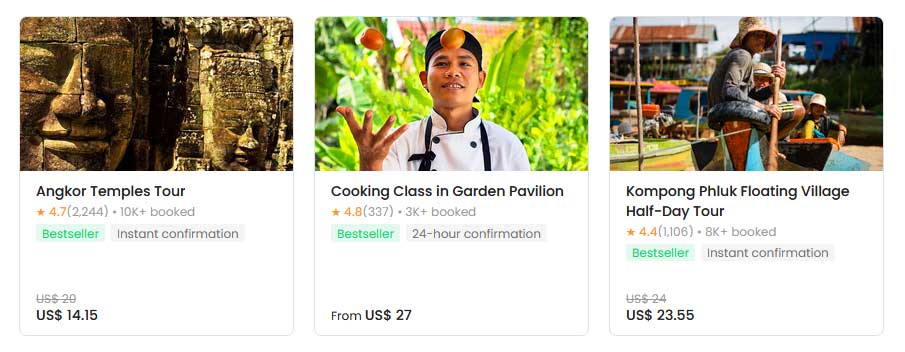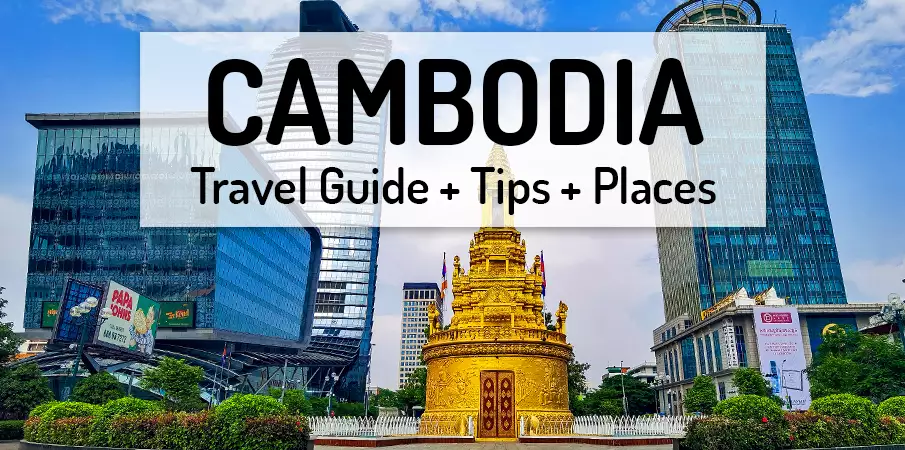
ℹ️ Useful Information
✈️ How to get there
🚍 Transport Options
☀️ Weather Forecast
🏡 Where to stay
🔍 Activities + Places
❓ FAQ + Travel Tips
🎫 Book a Tour Online
🎫 Book Tickets / Car
Quick answer: Cambodia is a deeply moving destination where ancient temples, peaceful countryside, and a resilient culture come together. From the majestic Angkor complex to the quiet life along the Mekong and Tonlé Sap, the country offers a blend of history, spirituality, and nature. Whether you’re exploring temple ruins, learning about Khmer traditions, or relaxing in small towns, Cambodia gives a meaningful and memorable travel experience.
At a glance:
- 🛕 Temples & History: Explore iconic sites like Angkor Wat, Ta Prohm, and Bayon.
- 🌿 Nature & Rural Life: Visit the countryside, floating villages on Tonlé Sap, and quiet hills.
- 🎭 Culture & Traditions: Rich Khmer culture — traditional dance, strong family ties, and important festivals.
- 🏙️ Phnom Penh: A mix of royal heritage, museums, and reminders of recent history.
- 🍲 Food & Local Life: Try local dishes, eat street food, and experience community markets.
- 🏞️ Scenic Nature Spots: Hills like Phnom Santuk and lush green landscapes offer great viewpoints.
- 📅 Best Time to Visit: Good weather generally November–March; monsoon can affect travel.
- 🛡️ Travel Tips: Respect cultural norms, plan temple visits early (sunrise recommended), and consider local guides for deeper insights.
Last updated in November 2025.
Discovering Cambodia: A Land of Beauty and Diversity:
Cambodia, a mesmerizing country in Southeast Asia, boasts a rich tapestry of history and natural wonders. Nestled between Thailand to the west, Laos to the north, Vietnam to the east, and the Gulf of Thailand to the south, Cambodia’s strategic location has played a pivotal role in shaping its history and culture.
-
- Geographical Features: Landscapes: Cambodia’s topography is diverse, ranging from lush lowlands and fertile plains to forested plateaus and rugged mountains. The mighty Mekong River flows through the heart of the country, providing a lifeline for agriculture and transportation.
- The Tonle Sap Lake: Notable for its unique phenomenon, the Tonle Sap Lake is the largest freshwater lake in Southeast Asia. During the monsoon season, its water levels swell, and it becomes the „Great Lake,“ increasing its size dramatically and sustaining a remarkable ecosystem.
- Climate: Cambodia experiences a tropical climate, with two distinct seasons. The dry season lasts from November to April, characterized by hot temperatures and little rainfall. The wet season, from May to October, brings refreshing rains, vital for agriculture, but also occasional flooding.
- Biodiversity: Cambodia is a biodiversity hotspot, home to a plethora of flora and fauna. Its lush forests harbor a diverse range of wildlife, including Asian elephants, tigers, leopards, and various bird species. Unfortunately, deforestation and habitat loss have posed significant challenges to conservation efforts.
- Key Landmarks: Angkor Wat: A UNESCO World Heritage Site, Angkor Wat is a breathtaking temple complex in Siem Reap. As the largest religious monument in the world, it stands as a symbol of national pride and is a testament to Cambodia’s glorious past as the Khmer Empire.
- Phnom Penh: The capital city, situated at the confluence of the Mekong, Tonle Sap, and Bassac rivers, offers a blend of traditional Khmer architecture and modern development. The Royal Palace, National Museum, and bustling markets are some of its fascinating attractions.
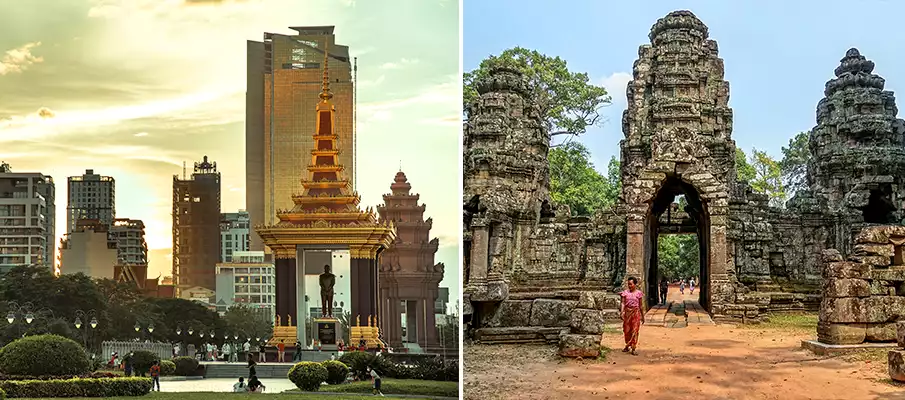
History of Cambodia: A Journey Through Time
Cambodia’s history is a captivating tale of resilience, grandeur, and transformation. From ancient empires to colonial influences and modern-day challenges, the country’s past has left an indelible mark on its culture and identity.
-
- Ancient Glory: The Khmer Empire At the heart of Cambodia’s history lies the remarkable Khmer Empire, which flourished from the 9th to the 15th century. The empire’s apex was marked by the construction of awe-inspiring temples, most notably the majestic Angkor Wat. The Khmer rulers‘ ingenuity in water management and agricultural practices sustained a prosperous civilization.
- Dark Ages: Decline and Revival As the Khmer Empire waned, Cambodia experienced a turbulent period of decline. Frequent invasions from neighboring empires, including the Siamese and the Vietnamese, weakened the region. The 15th-century marks the fall of Angkor, and Cambodia entered a phase of political fragmentation.
- Colonial Era: European Influence In the 19th century, Cambodia fell under French colonial rule. The French influence introduced new administrative systems, modern infrastructure, and education, but it also brought exploitation and challenges for the local population. Cambodia became part of French Indochina alongside Vietnam and Laos.
- Independence and Troubled Times Cambodia regained independence from France in 1953. However, the mid-20th century saw Cambodia embroiled in regional conflicts, particularly during the Vietnam War. The country became entangled in the Vietnam War’s aftermath, leading to political instability and the rise of the Khmer Rouge.
- The Khmer Rouge Era: Tragedy and Resilience The Khmer Rouge, led by Pol Pot, took control of Cambodia in 1975. Under their brutal regime, the country endured one of the darkest periods in history. Forced labor, mass executions, and widespread atrocities led to the deaths of approximately two million people. It was only in 1979 that the Khmer Rouge was overthrown, and the country began the long road to recovery.
- A Path to Progress: Rebuilding and Reconciliation Since the end of the Khmer Rouge regime, Cambodia has made significant strides towards rebuilding its nation. Efforts towards justice, reconciliation, and development have been ongoing, although challenges remain. Tourism has blossomed, as visitors from around the world come to witness the country’s rich heritage and natural wonders.
BOOK a TOUR / ACTIVITY in Cambodia ➜
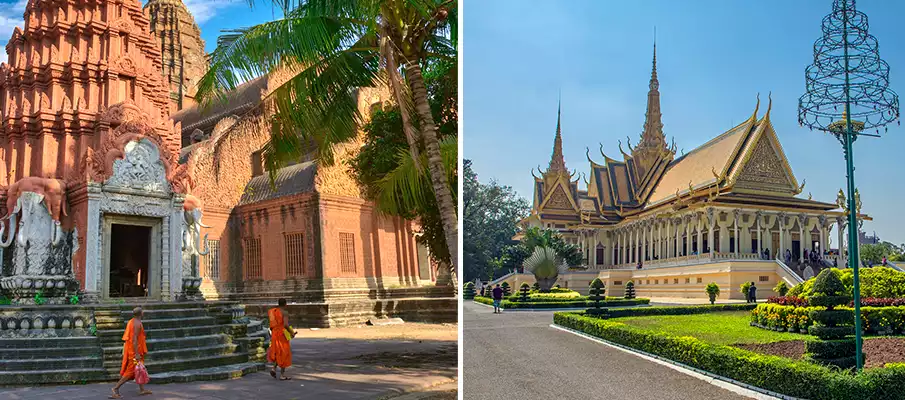
Vibrant Culture and Important Festivals of Cambodia:
Cambodia’s rich cultural heritage is a captivating blend of ancient traditions and modern influences. Its vibrant festivals add splashes of color and excitement to the country’s tapestry of traditions, reflecting the spirit and resilience of its people.
-
- Cultural Heritage: Cambodia’s culture revolves around the concept of „Sangsaar,“ emphasizing respect for elders, strong family bonds, and a deep reverence for spirituality. Traditional arts like Apsara dance, classical music, and Khmer martial arts are cherished as expressions of the country’s identity.
- Khmer New Year (Choul Chnam Thmey): Celebrated in mid-April, Khmer New Year is one of the most important festivals in Cambodia. Lasting for three days, the festivities include family gatherings, temple visits, and colorful processions. Water plays a significant role, as people splash each other as a symbol of cleansing and renewal.
- Bon Om Touk (Water Festival): Held during the full moon of November, Bon Om Touk is a grand water festival celebrated along the banks of the Tonle Sap River in Phnom Penh. The event pays tribute to the river’s unique reversal of flow and features boat races, fireworks, and illuminated floats.
- Pchum Ben (Ancestor’s Day): Pchum Ben, a fifteen-day festival in September or October, is a solemn occasion to honor deceased ancestors and pay respects to their souls. Families visit pagodas, offer food to monks, and make offerings to wandering spirits to ensure their ancestors‘ well-being.
- Royal Ploughing Ceremony (Chroat Preah Nongkoal): An ancient ritual held in May, the Royal Ploughing Ceremony marks the beginning of the planting season. The royal oxen are guided to plow a ceremonial furrow, and court astrologers predict the upcoming agricultural prospects based on the oxen’s chosen crops.
- Cambodia’s Festive Spirit: The festivals of Cambodia mirror the nation’s enduring spirit, fostering a sense of unity and pride among its people. These celebrations not only preserve age-old traditions but also provide a glimpse into the country’s vibrant present and promising future.
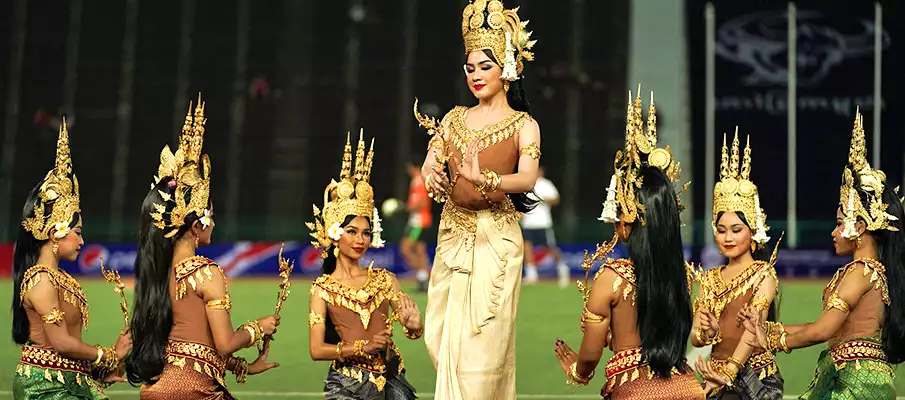
Religion in Cambodia: A Spiritual Mosaic.
-
- Religion in Cambodia: Cambodia, a nation renowned for its ancient temples, lush landscapes, and vibrant culture, boasts a rich tapestry of religions. The predominant faith is Theravada Buddhism, which shapes the spiritual and cultural landscape of the country. However, Cambodia’s religious diversity extends beyond Buddhism, with indigenous beliefs and other faiths adding depth to its spiritual mosaic.
-
- Theravada Buddhism: Theravada Buddhism holds a central place in Cambodian society, deeply influencing the lives of its people. Monasteries, adorned with intricate designs and exquisite architecture, dot the Cambodian landscape. Monks, known as ‚bhikkhus,‘ play a vital role in guiding the faithful and preserving the country’s cultural heritage. Cambodians participate in Buddhist rituals, including almsgiving and temple visits, to seek spiritual growth and cultivate merit.
-
- Indigenous Beliefs: Before Buddhism’s arrival, Cambodia was home to indigenous animist beliefs. These traditions continue to coexist with Buddhism, emphasizing a reverence for ancestors and a close connection with the natural world. Cambodians pay respects to their ancestors through various ceremonies and seek blessings from the spirits believed to inhabit the land, rivers, and mountains.
-
- Religious Diversity: While Theravada Buddhism is the dominant religion, Cambodia is home to a diverse population of other religious communities. Christianity, primarily Catholicism, has found followers among both urban and rural populations. Islam, too, has a presence, particularly among the Cham ethnic minority. This diversity in religious beliefs reflects Cambodia’s openness to a variety of faiths.
-
- Religious Tolerance and Unity: Cambodia’s government promotes religious freedom and coexistence, enshrining these principles in its constitution. The nation’s religious landscape is a testament to the tolerance and unity among its people, who respect and honor different faiths. The harmonious coexistence of diverse religious communities is a source of pride, strengthening the social fabric of the nation.
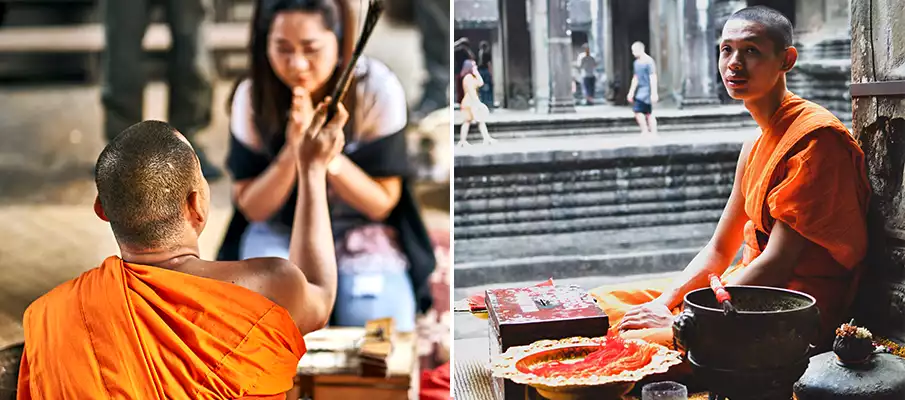
Economy of Cambodia: A Tale of Resilience and Growth.
Cambodia’s economy has undergone remarkable transformations over the past few decades, evolving from a war-torn nation to one of the fastest-growing economies in Southeast Asia. This journey of resilience and growth has been fueled by diverse sectors and a focus on attracting foreign investments.
-
- Agriculture: The Backbone of the Economy Agriculture remains the backbone of Cambodia’s economy, employing a significant portion of the population. Rice cultivation is the dominant agricultural activity, with Cambodia being a major rice exporter in the region. Other key crops include rubber, cassava, and cashews.
- Garment and Textile Industry: Export Success The garment and textile sector have played a crucial role in Cambodia’s economic growth. The industry has become a major export earner, catering to global fashion brands. Its success has provided employment opportunities and contributed significantly to the country’s export revenues.
- Tourism: A Thriving Sector Cambodia’s cultural heritage, ancient temples, and natural wonders have made it an increasingly popular tourist destination. The tourism sector has experienced substantial growth, attracting visitors from around the world and generating revenue for the economy.
- Manufacturing and Construction: Driving Growth The manufacturing and construction industries have flourished in recent years, driven by foreign investments and domestic demand. Cambodia’s strategic location and preferential trade agreements have made it an attractive destination for investors, boosting industrial activities.
- Foreign Direct Investment: A Key Catalyst Foreign direct investment (FDI) has played a vital role in Cambodia’s economic development. The government has introduced various incentives to attract foreign investors, leading to the establishment of factories, infrastructure projects, and other business ventures.
- Challenges and Opportunities: Despite impressive progress, Cambodia faces several challenges. Poverty, income inequality, and the need for better infrastructure remain pressing issues. Additionally, the country’s heavy reliance on the garment sector and vulnerability to external shocks require diversification efforts.
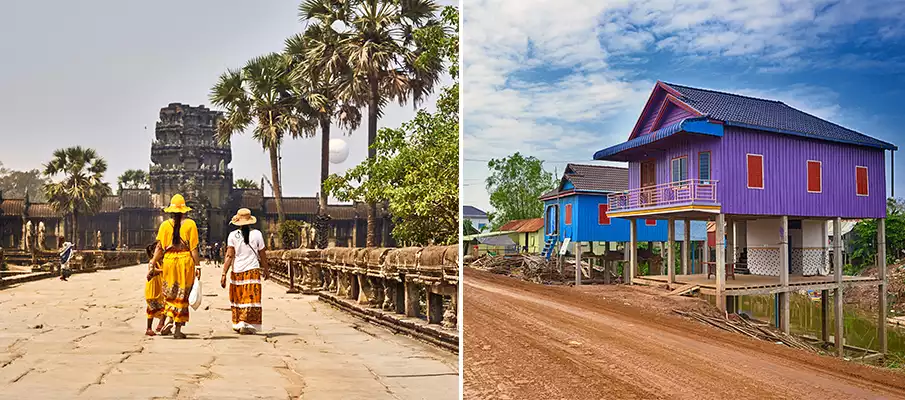
Tourism in Cambodia: Unveiling the Kingdom’s Hidden Treasures
Tourism in Cambodia has flourished in recent years, drawing travelers from across the globe to explore the country’s rich cultural heritage, breathtaking landscapes, and warm hospitality. From ancient temples to pristine beaches, Cambodia offers a captivating journey that leaves visitors enchanted with its hidden treasures.
-
- Ancient Marvels: The Temples of Angkor At the heart of Cambodia’s tourism allure stands the magnificent Angkor Archaeological Park, home to the iconic Angkor Wat and other awe-inspiring temples. Built by the Khmer Empire, these ancient marvels transport visitors back in time, evoking a sense of wonder and admiration.
- The Capital Charm: Phnom Penh Cambodia’s bustling capital, Phnom Penh, is a vibrant hub that effortlessly blends tradition with modernity. Here, visitors can explore the Royal Palace, immerse in the country’s history at the National Museum, and pay tribute to the past at the haunting Killing Fields.
- Serene Beach Escapes: Sihanoukville and Islands For those seeking relaxation, Cambodia’s coastline offers tranquil havens like Sihanoukville and the nearby islands. With their white sandy beaches and crystal-clear waters, these idyllic destinations provide a perfect escape from the hustle and bustle of city life.
- Cultural Immersion: Local Festivals and Cuisine Tourists in Cambodia have the unique opportunity to partake in traditional festivals like Khmer New Year and Pchum Ben, celebrating alongside locals and experiencing the country’s vibrant culture up close. Moreover, the diverse Khmer cuisine tantalizes taste buds with its delightful flavors and aromatic spices.
- Eco-Tourism Adventures: Wildlife and Nature Reserves Nature enthusiasts can explore Cambodia’s rich biodiversity by visiting wildlife sanctuaries and nature reserves. The Cardamom Mountains and Mondulkiri Province offer glimpses of rare wildlife species, while the Tonle Sap Lake boasts a unique floating village experience.
- Community-Based Tourism: Embracing Responsible Travel Cambodia’s tourism industry has embraced community-based initiatives, encouraging travelers to engage responsibly with local communities and support sustainable practices. This approach not only benefits the environment but also empowers local populations economically.
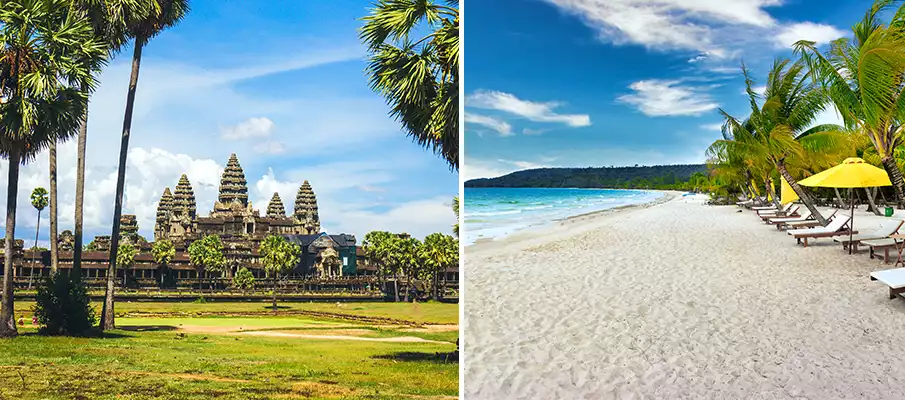
The biggest and frequented tourist cities in Cambodia:
Cambodia, a land of enchanting wonders, boasts several captivating cities that draw tourists from all corners of the globe. Here are some of the biggest and most frequented tourist cities in the Kingdom:
-
- 1. Siem Reap: The Gateway to Angkor Siem Reap, located in northwest Cambodia, is synonymous with the awe-inspiring Angkor Archaeological Park. Home to the iconic Angkor Wat, Bayon Temple, and other ancient wonders, Siem Reap offers a mesmerizing journey through the remnants of the Khmer Empire. Besides its archaeological treasures, the city boasts a vibrant nightlife, bustling markets, and a delightful blend of Khmer and international cuisines.
- 2. Phnom Penh: The Capital of Contrasts As Cambodia’s bustling capital, Phnom Penh offers a dynamic blend of tradition and modernity. The city houses historical landmarks like the Royal Palace, Silver Pagoda, and the poignant Tuol Sleng Genocide Museum. While it embraces its past, Phnom Penh also boasts a thriving arts scene, chic cafes, and lively riverfronts. Visitors can witness traditional Apsara dance performances and savor delectable Khmer street food amidst the city’s vibrant energy.
- 3. Sihanoukville: A Coastal Paradise Sihanoukville, nestled along the Gulf of Thailand, is Cambodia’s premier coastal destination. With its pristine white-sand beaches, turquoise waters, and a variety of water sports, the city offers a relaxing retreat. Serendipity Beach and Otres Beach are popular spots for sun-seekers, while Ream National Park invites nature enthusiasts to explore its lush landscapes and diverse wildlife.
- 4. Battambang: A Haven of Culture and Arts Battambang, in the northwest, exudes a laid-back charm and is known for its artistic and cultural heritage. The city showcases French colonial architecture, traditional Cambodian wooden houses, and a thriving art scene. Tourists can take a leisurely ride on the Bamboo Train or visit the Killing Caves to understand Cambodia’s tragic past.
- 5. Kampot: A Riverside Gem Nestled along the banks of the Kampot River, Kampot offers a serene escape from the bustling cities. The city is famous for its pepper plantations, and visitors can take tours to learn about the region’s pepper farming. Kampot’s laid-back atmosphere, scenic river cruises, and stunning sunsets make it a beloved destination for travelers seeking tranquility.
- 6. Kep: A Coastal Retreat Known for its tranquil beaches and fresh seafood, Kep is a charming coastal town in the south of Cambodia. The Kep National Park offers breathtaking views, while the iconic Crab Market is a must-visit for seafood aficionados. Kep’s relaxed ambiance and scenic landscapes make it an ideal destination for a peaceful getaway.
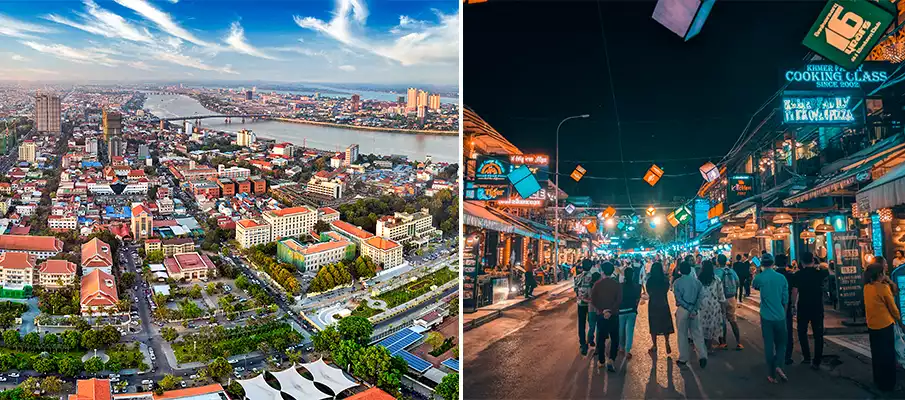
The Most Popular and Visited Tourist Places in Cambodia:
Cambodia, a land of ancient temples, rich culture, and natural beauty, captivates travelers with its diverse attractions. Here are some of the most popular and visited tourist places in the Kingdom:
-
- 1. Angkor Archaeological Park, Siem Reap: Angkor Archaeological Park is the crown jewel of Cambodia’s tourism. Home to the awe-inspiring Angkor Wat, the world’s largest religious monument, this UNESCO World Heritage Site boasts a vast complex of ancient temples and structures. Visitors can explore the intricate carvings of Bayon Temple, the mystical Ta Prohm (Tomb Raider temple), and numerous other architectural marvels that reveal the grandeur of the Khmer Empire.
- 2. Royal Palace and Silver Pagoda, Phnom Penh: In the bustling capital of Phnom Penh, the Royal Palace stands as a symbol of Cambodia’s monarchy. The Royal Palace complex includes the opulent Silver Pagoda, adorned with silver tiles and housing a precious Emerald Buddha. The fusion of traditional Khmer and French architectural styles makes this a must-visit attraction.
- 3. Sihanoukville Beaches and Islands: Sihanoukville, on Cambodia’s southwestern coast, is renowned for its pristine beaches and nearby islands. Serendipity Beach, Ochheuteal Beach, and Sokha Beach are popular spots for sunbathing and water activities. For a more secluded experience, tourists can visit Koh Rong and Koh Rong Samloem islands, where crystal-clear waters and serene landscapes await.
- 4. Bayon Temple, Angkor Thom: Located within the ancient city of Angkor Thom, the Bayon Temple is famous for its mesmerizing stone faces. The temple’s towers are adorned with over 200 gigantic smiling faces, creating an enigmatic and enchanting atmosphere that leaves visitors spellbound.
- 5. Ta Prohm, Siem Reap: Ta Prohm, a temple within the Angkor complex, is renowned for its mystical and overgrown appearance. Ancient trees have intertwined with the temple’s structure, creating a unique and atmospheric setting. The sight of massive tree roots entwined with the ancient ruins is an unforgettable sight.
- 6. Banteay Srei, Siem Reap: Banteay Srei, also known as the „Citadel of Women,“ is a small but exquisitely detailed temple within the Angkor complex. It is renowned for its intricate carvings and pink sandstone construction, showcasing the finest examples of classical Khmer art.
- 7. Preah Vihear Temple: Perched atop the Dangrek Mountains, Preah Vihear Temple offers stunning panoramic views of the Cambodian lowlands. Its remote location adds to the allure, making it a must-visit for adventurous travelers seeking off-the-beaten-path experiences.
BOOK a TOUR / ACTIVITY in Cambodia ➜
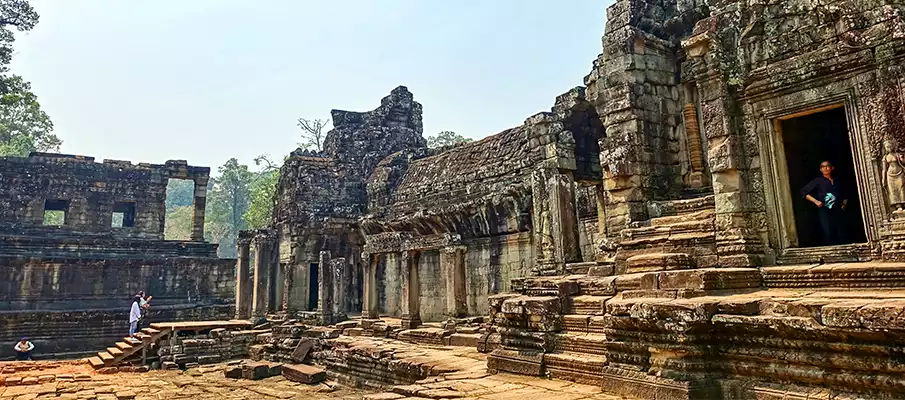
10 Important Historical Sites / Temples in Cambodia:
Cambodia’s historical sites and temples are a testament to the country’s glorious past and the architectural achievements of the Khmer Empire. These awe-inspiring monuments draw visitors from around the world, offering glimpses into Cambodia’s rich cultural heritage. Here are ten significant historical sites and temples worth exploring:
-
- 1. Angkor Wat, Siem Reap: The crown jewel of Cambodia’s historical sites, Angkor Wat, is the largest religious monument in the world. Built during the 12th century, this iconic temple showcases intricate carvings and stunning architectural symmetry, reflecting the pinnacle of Khmer architecture and Hindu-Buddhist influence.
- 2. Bayon Temple, Angkor Thom: Known for its enigmatic stone faces, Bayon Temple is located within the ancient city of Angkor Thom. The temple’s towers are adorned with over 200 massive smiling faces, creating an otherworldly and captivating atmosphere.
- 3. Ta Prohm, Siem Reap: Ta Prohm is famous for its intertwining tree roots, which have grown over and around the temple’s structures, creating a unique and hauntingly beautiful scene. This temple was featured in the movie „Lara Croft: Tomb Raider.“
- 4. Preah Vihear Temple: Perched on a clifftop in the Dangrek Mountains, Preah Vihear Temple offers breathtaking views of Cambodia’s lowlands. Its strategic location and intricate architectural details make it a remarkable UNESCO World Heritage Site.
- 5. Banteay Srei, Siem Reap: Banteay Srei, the „Citadel of Women,“ is renowned for its intricate and well-preserved carvings. Constructed from pink sandstone, this temple displays some of the finest examples of classical Khmer art.
- 6. Koh Ker: Koh Ker served as the capital of the Khmer Empire for a brief period during the 10th century. The site is home to numerous temples, including the Prasat Thom, a seven-tiered pyramid temple offering panoramic views.
- 7. Preah Khan, Angkor: Preah Khan, meaning „Royal Sword,“ was once a grand monastic complex and a significant center of learning and worship. Today, it stands as a captivating temple ruin, featuring elaborate carvings and ancient corridors.
- 8. Royal Palace, Phnom Penh: The Royal Palace, located in Phnom Penh, is a significant and iconic architectural landmark in Cambodia. It serves as the official residence of the King of Cambodia and a symbol of the country’s monarchy.
- 9. Sambor Prei Kuk, Kampong Thom: Sambor Prei Kuk is an ancient temple complex predating Angkor, dating back to the 7th century. The site boasts numerous brick temples adorned with unique decorative elements.
- 10. Phnom Bakheng, Siem Reap: Phnom Bakheng is a hilltop temple that provides breathtaking sunset views over Angkor Wat. This temple, constructed in the form of a pyramid, is a popular spot for visitors seeking a mesmerizing sunset experience.
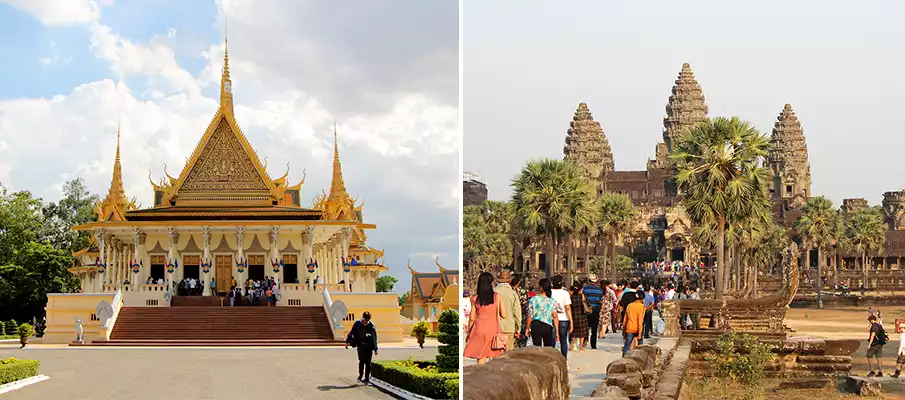
6 Most Popular Islands and Beach Destinations in Cambodia:
Cambodia is known for its rich cultural heritage and stunning landscapes, and while it may not have as many islands as some of its neighbors, there are a few popular islands that have been attracting tourists in recent years. Here are some of the most popular islands in Cambodia for tourists:
-
- Koh Rong: Koh Rong is perhaps the most famous Cambodian island. It’s known for its beautiful beaches, crystal-clear waters, and vibrant nightlife. Visitors can enjoy water sports, trek through the jungle, and relax on sandy shores. The island has also become a hub for backpackers and budget travelers.
-
- Koh Rong Samloem: Located near Koh Rong, Koh Rong Samloem is a quieter alternative. It offers a more relaxed and less crowded atmosphere. The island is ideal for those seeking a tranquil escape, with pristine beaches and crystal waters.
-
- Koh Thmei: Koh Thmei is part of Ream National Park, and it’s a destination for eco-tourism and nature lovers. The island is home to diverse wildlife and lush mangrove forests. It’s a great place for birdwatching, hiking, and enjoying the unspoiled nature.
-
- Koh Ta Kiev: Koh Ta Kiev is another quiet island, perfect for travelers looking for a more laid-back experience. It offers simple beach bungalows, hammocks, and a rustic, back-to-basics vibe. You can enjoy the serene beaches and explore the island’s forests.
-
- Koh Tang: Koh Tang is a popular spot for scuba diving and snorkeling. It’s known for its underwater biodiversity, with colorful coral reefs and various marine species. The island also has a rich history, as it was the site of a military conflict during the 1970s.
-
- Koh Kong: Koh Kong has been gaining popularity as a tourist destination due to its natural beauty. Tourists are drawn to the province for its pristine beaches, nearby islands, and the Cardamom Mountains, which offer opportunities for trekking, wildlife observation, and eco-tourism.
Please note that Cambodia’s island tourism is still developing, and while these islands offer unique experiences, they may not have the same level of infrastructure and amenities as more established destinations in other countries. Always check the latest travel information and accommodations before planning your trip to these Cambodian islands.
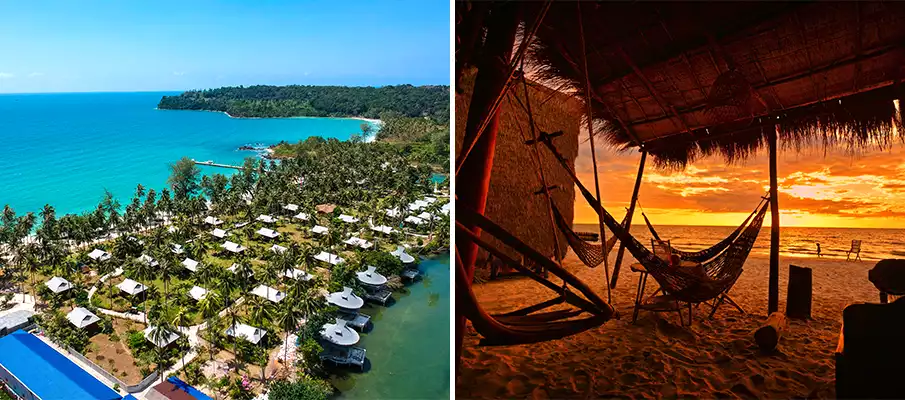
Activities and Adventure for tourists visiting Cambodia:
Cambodia, with its diverse landscapes and rich cultural heritage, offers an array of exciting activities and adventurous experiences for tourists seeking a memorable journey. From exploring ancient temples to immersing in natural wonders, here are some must-try activities for travelers visiting Cambodia:
-
- 1. Exploring the Temples of Angkor: Embark on a captivating adventure through the ancient temples of Angkor Archaeological Park in Siem Reap. Rent a bicycle or hire a tuk-tuk driver to explore the vast temple complex, including the iconic Angkor Wat, Bayon, Ta Prohm, and more. Watching the sunrise or sunset over the majestic temples adds a magical touch to the experience.
- 2. Boat Tours on Tonle Sap Lake: Take a boat tour on the massive Tonle Sap Lake near Siem Reap to witness the unique floating villages and diverse aquatic life. The boat ride provides an immersive glimpse into the traditional lifestyles of local communities living on the water.
- 3. Zip-lining and Jungle Trekking: Head to the lush jungles of Mondulkiri or the Cardamom Mountains for thrilling zip-lining adventures and jungle trekking. These pristine landscapes offer an opportunity to spot rare wildlife and immerse in the untouched beauty of Cambodia’s natural wonders.
- 4. River Cruises in Phnom Penh: Experience the charm of Phnom Penh with a relaxing river cruise along the Tonle Sap and Mekong rivers. Enjoy the scenic views of the city’s skyline and its historic landmarks while savoring a delicious dinner on board.
- 5. Dolphin Watching in Kratie: Visit Kratie, a riverside town on the Mekong River, for a chance to spot the rare Irrawaddy dolphins. Take a boat trip to the Kampi dolphin pool and witness these gentle creatures playing in their natural habitat.
- 6. Beach Hopping in Sihanoukville: Relax and unwind on the beautiful beaches of Sihanoukville, known for its vibrant coastal atmosphere. From the lively Serendipity Beach to the tranquil Sokha Beach, each location offers a unique beach experience.
- 7. Trekking in Ratanakiri: Ratanakiri, in northeastern Cambodia, offers trekking opportunities to explore remote tribal villages, lush forests, and stunning waterfalls. Immerse in the indigenous culture and learn about their traditional customs.
- 8. Quad Biking in Battambang: Embark on an adrenaline-pumping quad biking adventure through the countryside of Battambang. Explore rural landscapes, rice fields, and charming villages, witnessing the local way of life.
- 9. Kite Surfing in Koh Rong Samloem: Koh Rong Samloem island is an ideal destination for kite surfing enthusiasts. The island’s pristine beaches and steady winds provide the perfect conditions for this exciting water sport.
- 10. Cambodian Cooking Classes: Participate in a cooking class to learn the secrets of Khmer cuisine. Local chefs will guide you through the preparation of traditional dishes, allowing you to savor the flavors of Cambodia even after your trip.
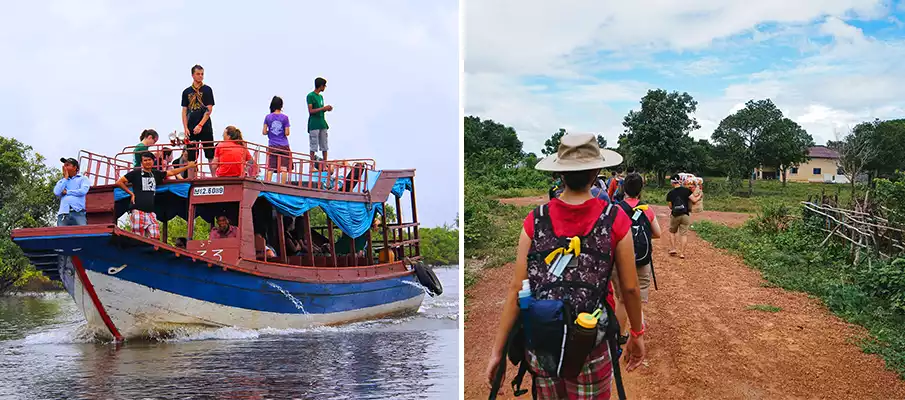
How to Behave and What to Watch Out for in Cambodia?
When visiting this fascinating country, it’s important to keep in mind that respect for local culture and traditions is the key to a successful and enjoyable stay. There’s no need to worry as long as you remember a few simple rules and tips on how to behave and what to watch out for.
-
- Clothing: Local culture emphasizes modesty. Clothing should cover your shoulders and knees, especially when visiting temples and sacred places.
-
- Religion: Cambodia is predominantly a Buddhist country. Respect Buddhist sanctuaries and avoid disrespectful behavior.
-
- Photography: Keep in mind that not everyone in Cambodia wants to be photographed. Always ask if it’s okay to take pictures and be considerate.
-
- Modesty: Public displays of affection are relatively uncommon in Cambodia. Be modest if you’re a couple.
-
- Respect for Locals: Show respect and politeness to local people. Local residents are usually very friendly.
-
- Safety: Keep an eye on your valuables and be cautious, especially in tourist areas and busy markets.
-
- Healthcare: Have valid travel insurance and follow health precautions such as insect repellent and vaccinations.
-
- Nature Conservation: Respect Cambodia’s natural beauty and avoid littering in nature. Observe bans on hunting and harming protected species.
-
- Local Food: Cambodian cuisine is delicious and diverse. Make sure to eat at clean and reliable places to avoid food-related issues.
-
- Historical Monuments: Cambodia has a rich history and is known for its temple complexes like Angkor Wat. Respect historical monuments and avoid vandalizing them.
Traveling in Cambodia can be an unforgettable experience, encompassing the discovery of a captivating history, natural beauty, and interactions with kind local residents. Respecting local culture and customs is not only a way to have a harmonious stay but also a way to deepen your understanding of this incredible country. Remember that local people will gladly show you their hospitality if you approach them with openness and respect.
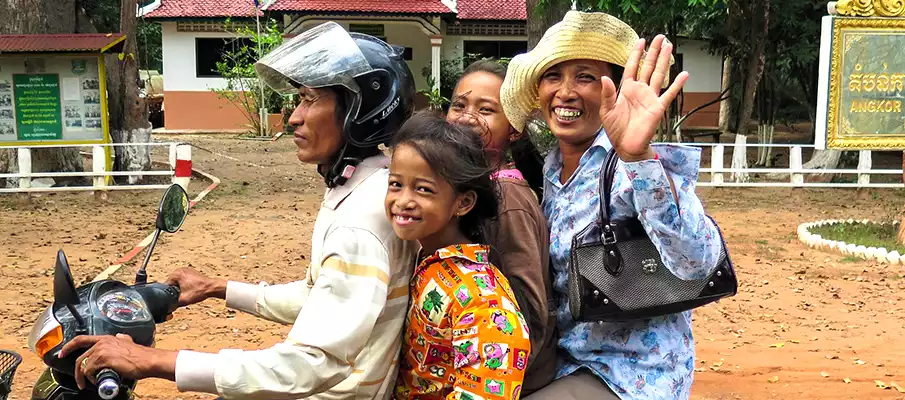
Is it suitable to travel to Cambodia with children?
Traveling to Cambodia with children can be a captivating and educational experience, but it’s essential to be aware of both the advantages and challenges when planning a family trip to this Southeast Asian nation. Cambodia offers a mix of historical wonders, natural beauty, and cultural richness that can leave a lasting impression on young minds.
👉 Why to travel to Cambodia with children:
-
- Cultural Enrichment: Cambodia is home to some of the world’s most famous cultural landmarks, including the Angkor Wat temple complex. Exploring these ancient sites with your children can be an educational and awe-inspiring experience.
- Natural Beauty: From pristine beaches and lush jungles to serene rivers and unique wildlife, Cambodia’s diverse landscapes offer numerous opportunities for outdoor adventures and nature education.
- Affordability: Cambodia is generally an affordable destination, making it suitable for families on a budget. Accommodation, food, and transportation are reasonably priced.
- Warm and Friendly Locals: Cambodians are known for their warm and welcoming hospitality, making it easier for families to feel at ease and experience the local culture firsthand.
- Unique Experiences: Children can engage in activities such as exploring floating villages, taking boat trips on the Tonle Sap Lake, or discovering the vibrant markets, offering a taste of authentic Cambodian life.
👉 Why do not travel to Cambodia with children:
-
- Health and Safety: Cambodia faces healthcare challenges, particularly in rural areas. It’s vital to ensure your children have necessary vaccinations, travel insurance, and access to quality medical care if needed.
- Language Barrier: While English is spoken in tourist areas, language barriers might arise in remote regions, which can make communication and navigation more challenging.
- Long Travel Distances: Cambodia is a sizable country, and some road conditions are less than ideal. Long journeys between attractions may be tiring for children, and travel can be time-consuming.
- Cultural Sensitivity: Teaching children to respect local customs, traditions, and etiquette is crucial to ensure a harmonious and respectful experience.
- Limited Amenities: Some rural areas might lack modern amenities, such as western-style toilets and air-conditioning, which can impact the comfort of the trip.
In summary, traveling to Cambodia with children offers a blend of cultural exploration and natural beauty. While it can be a rewarding experience, it’s crucial to plan and prepare for potential challenges, ensuring your family can make the most of their journey. With the right precautions and cultural awareness, Cambodia can be an enriching destination for families, offering a glimpse into a unique and captivating world.
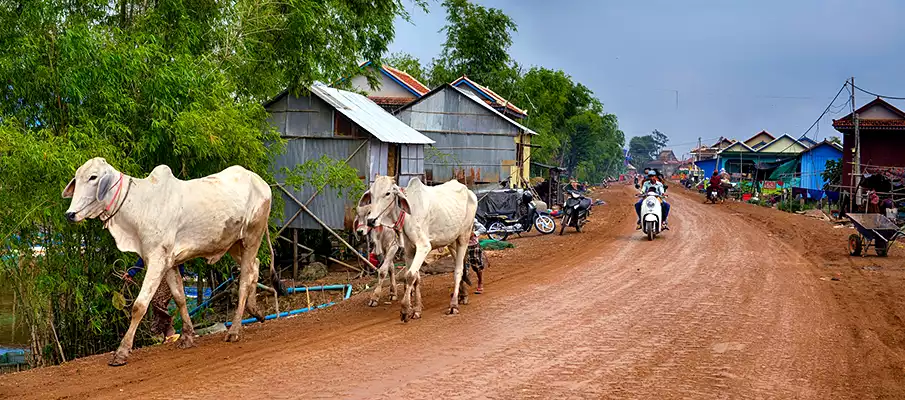
Food and Cuisine in Cambodia / Popular Foods:
Cambodian cuisine is a delightful fusion of flavors, influenced by the country’s rich history and vibrant culture. From fragrant curries to refreshing salads, Cambodia’s culinary offerings promise a unique and unforgettable gastronomic experience. Here are some popular foods that capture the essence of Cambodian cuisine:
-
- 1. Amok (Fish Curry): Amok is a quintessential Cambodian dish, often considered the country’s national dish. This creamy curry is made with fish, coconut milk, and an aromatic blend of spices, including turmeric, lemongrass, and galangal. It is traditionally steamed in banana leaves, imparting a subtle herbal aroma.
- 2. Bai Sach Chrouk (Pork and Rice): A popular breakfast dish, Bai Sach Chrouk consists of marinated pork grilled over charcoal and served with steamed rice. The pork is marinated with garlic, soy sauce, and coconut milk, creating a flavorful combination.
- 3. Nom Banh Chok (Khmer Noodles): Nom Banh Chok is a traditional Cambodian noodle dish, featuring rice noodles topped with a savory fish-based green curry sauce. The dish is typically garnished with fresh herbs, bean sprouts, and cucumbers.
- 4. Lok Lak (Stir-Fried Beef): Lok Lak is a beloved Cambodian stir-fry dish, featuring tender beef cubes marinated in a tangy sauce and served with a side of fresh vegetables. The dish is commonly accompanied by a zesty lime and black pepper dipping sauce.
- 5. Kuy Teav (Noodle Soup): Kuy Teav is a flavorful noodle soup made with pork or beef broth, served with rice noodles and topped with ingredients like bean sprouts, green onions, and cilantro. It is a popular breakfast or comfort food option.
- 6. Fish Amok: Similar to the traditional Amok, Fish Amok replaces the meat with freshwater fish, commonly tilapia or catfish. The dish retains the fragrant curry flavors while offering a delightful seafood twist.
- 7. Prahok Ktiss (Fermented Fish Dip): Prahok Ktiss is a pungent and delicious fermented fish dip, often served with fresh vegetables and rice. It is a popular condiment in Cambodian cuisine, adding a unique depth of flavor to meals.
- 8. Nom Pang (Cambodian Sandwich): Nom Pang is Cambodia’s version of a sandwich, typically filled with a variety of ingredients like grilled meats, pickled vegetables, and condiments, all served in a baguette or crispy bread.
- 9. Green Mango Salad: A refreshing and tangy salad, Green Mango Salad combines shredded green mangoes with herbs, peanuts, and a zesty dressing, creating a perfect balance of sweet, sour, and spicy flavors.
- 10. Num Krok (Coconut Rice Cakes): Num Krok are coconut rice cakes made from rice flour, coconut milk, and palm sugar. These delicious treats are often served as a sweet snack or dessert.
BOOK a TOUR / ACTIVITY in Cambodia ➜
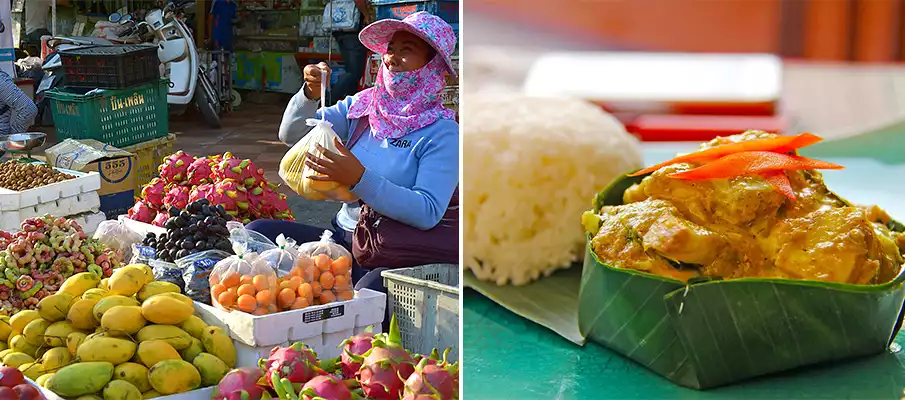
Why to visit or not to visit Cambodia?
Ultimately, whether to visit Cambodia or not depends on personal preferences and travel expectations. For those seeking a unique and culturally enriching experience, Cambodia’s ancient temples, warm hospitality, and natural beauty make it a must-visit destination. However, potential challenges like the climate and language barrier should be considered while planning the trip. Cambodia, with its allure as the „Kingdom of Marvels,“ beckons travelers with its magical blend of history, culture, and adventure.
👉 Reasons to visit Cambodia:
-
- Ancient Temples: Cambodia is home to the breathtaking temples of Angkor, including the majestic Angkor Wat. Exploring these ancient wonders is a mesmerizing journey back in time, offering a glimpse into the grandeur of the Khmer Empire.
- Rich Culture and Heritage: Cambodia’s vibrant culture and traditions are evident in its festivals, art, dance, and architecture. Interacting with friendly locals and witnessing traditional ceremonies provide immersive cultural experiences.
- Natural Beauty: From pristine beaches in Sihanoukville to lush jungles in Mondulkiri, Cambodia’s natural beauty is awe-inspiring. The country offers opportunities for eco-tourism, wildlife spotting, and tranquil escapes.
- Warm Hospitality: Cambodians are known for their warm and welcoming nature. Visitors often find themselves embraced by the genuine hospitality and friendliness of the locals.
- Affordability: Cambodia is a budget-friendly destination, making it attractive for travelers seeking diverse experiences without breaking the bank.
- Delicious Cuisine: Khmer cuisine is a delightful blend of flavors, with dishes like Amok, Lok Lak, and fresh seafood being highlights for food enthusiasts.
- Adventure Activities: Cambodia offers thrilling adventures, from exploring hidden temples to zip-lining through lush jungles and river cruises along scenic waterways.
👉 Reasons not to visit Cambodia:
-
- Hot and Humid Climate: Cambodia’s tropical climate can be challenging for some visitors, with high temperatures and humidity, especially during the peak summer months.
- Infrastructural Development: While major cities have modern amenities, some rural areas may have limited infrastructure, making travel more challenging in certain regions.
- Conservative Dress Code: Visitors are expected to dress modestly, especially when visiting religious sites. Some travelers may find this cultural difference restrictive.
- Language Barrier: While English is spoken in tourist areas, communication may be more challenging in rural or less touristy locations.
- Historical Sites Maintenance: The immense popularity of Angkor Wat and other temples has led to a higher number of visitors, resulting in some areas becoming crowded and challenging to preserve.
- Traffic and Road Safety: Traffic congestion and road conditions in major cities like Phnom Penh can be chaotic, requiring extra caution for travelers when navigating the streets.
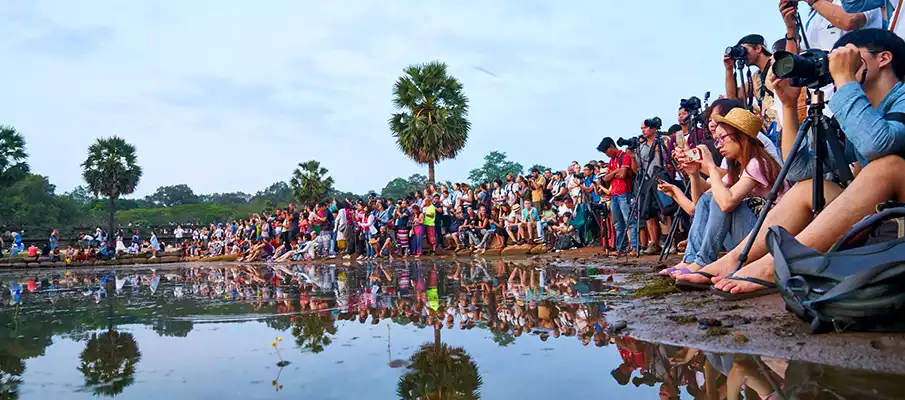
✈️ How to get and travel to Cambodia?
Traveling to Cambodia is relatively straightforward, and there are several ways to get to the country. The most comfortable and fastest options is to take a flight to Phnom Penh, Siem Reap or Sihanoukville. You can also arrive by bus from Thailand, Laos or Vietnam. Here’s a step-by-step guide on how to get and travel to Cambodia:
1. By Air to Cambodia: Cambodia is well-connected to several international airports. The two main airports are Techo International Airport (KTI) in Phnom Penh (opened in September 2025) and Siem Reap Angkor International Airport (SAI) near the Angkor Archaeological Park. Both airports receive flights from major cities in Asia, Europe, and other continents. Several airlines, including local carriers and international airlines, operate regular flights to Cambodia.
2. By Land to Cambodia: If you are traveling from neighboring countries, you can enter Cambodia via land borders. The most popular land border crossings are:
-
- Poipet: This border crossing connects Cambodia with Thailand and is one of the busiest entry points. It is accessible by bus from Bangkok and other major Thai cities.
- Bavet: Located on the Vietnam-Cambodia border, Bavet is a common entry point for travelers coming from Ho Chi Minh City in Vietnam. Buses and taxis operate between Ho Chi Minh City and Bavet.
- Koh Kong: This border crossing connects Cambodia with Thailand’s Trat province. It is the entry point for travelers coming from Bangkok and the Thai islands.
3. By Boat to Cambodia: For a unique and scenic experience, some travelers opt for river crossings from neighboring countries. The most common river crossing is between Vietnam and Cambodia via the Mekong River. There are boat services connecting Phnom Penh and Chau Doc in Vietnam.
-
- You can book tickets / flights to Cambodia on Baolau ➜ or 12go.asia ➜

🚍 What are the Transport Options in Cambodia?
Cambodia offers a range of transport options to suit various travel preferences and budgets. Here are the main transport options available in the country:
-
- 1. Tuk-Tuks: Tuk-tuks are a popular and convenient mode of transport in Cambodia, especially in cities like Phnom Penh and Siem Reap. These three-wheeled motorized vehicles can carry several passengers and are often used for short distances or sightseeing around tourist areas.
- 2. Taxis: Metered taxis and ride-hailing services like PassApp and Grab are available in major cities like Phnom Penh and Siem Reap. They offer a more comfortable and air-conditioned option for getting around the city.
- 3. Motorbike Taxis (Motodops): Motorbike taxis, known as „motodops,“ are a common sight in Cambodia. They are especially popular for short trips within cities or to locations where cars or tuk-tuks cannot easily access.
- 4. Buses: Cambodia has an extensive network of buses that connect major cities and towns. There are different types of buses available, including luxury coaches, minibuses, and local buses. Several companies operate bus services, offering various levels of comfort and ticket prices.
- 5. Trains: Cambodia’s railway network is limited but growing. Currently, there are train services connecting Phnom Penh to Sihanoukville and Battambang. Traveling by train provides a unique experience and a chance to see the countryside.
- 6. Domestic Flights: Cambodia has domestic flight options that connect Phnom Penh to Siem Reap and other destinations. Domestic flights are convenient for covering long distances quickly and are particularly useful if you want to save time and avoid lengthy bus journeys.
- 7. Renting a Motorbike or Bicycle: Renting a motorbike or bicycle is a popular option for travelers who prefer exploring at their own pace. In places like Siem Reap, Battambang, and Kampot, renting a bicycle or motorbike allows you to visit temples, local villages, and off-the-beaten-path attractions independently.
- 8. Ferries and Boats: Ferries and boats operate on various rivers and waterways in Cambodia, such as the Mekong River and Tonle Sap Lake. They offer scenic journeys and connections to some remote and beautiful locations.
- You can book tickets / flights in Cambodia on Baolau ➜ or 12go.asia ➜

☀️ Weather in Cambodia + The Best Time to Visit:
Cambodia has a tropical monsoon climate, characterized by distinct wet and dry seasons. The weather can vary significantly throughout the year, impacting travel experiences in different regions of the country.
Dry Season (November to April): The dry season is the most popular time to visit Cambodia, especially for tourists exploring historical sites like Angkor Wat. During this period, from November to April, the weather is generally hot and dry. Temperatures can range from pleasantly warm in November and December to hot and humid from January to April. March and April are the hottest months, with temperatures often exceeding 30°C (86°F).
Wet Season (May to October): The wet season, also known as the „green season,“ runs from May to October. During this time, Cambodia experiences regular rainfall, particularly from June to September. While the rain can be heavy at times, it typically falls in short, intense bursts. The wet season also brings lush vegetation and vibrant landscapes, making it an excellent time for photography and nature enthusiasts. However, some rural areas may become difficult to access due to flooding.
Best Time to Visit Cambodia: The best time to visit Cambodia largely depends on personal preferences and the type of experiences you seek:
- Peak Tourist Season (November to February): This is the peak tourist season when the weather is relatively cooler and dry. It is the ideal time for temple explorations and outdoor activities. However, expect larger crowds and higher hotel rates during this period.
- Shoulder Season (March to April): March and April are the hottest months, but they can still be a good time to visit if you can handle the heat. Prices for accommodations may be slightly lower during this time, and there will be fewer tourists compared to the peak season.
- Green Season (May to October): The wet season offers a unique experience with lush landscapes and fewer crowds. If you don’t mind occasional rain showers and want to avoid large tourist crowds, this might be the best time for you. Plus, some hotels and tour operators offer discounted rates during this season.
| Month | Weather | Description |
|---|---|---|
| January | Cool and Dry | In January, Cambodia experiences cool and dry weather, making it an ideal time to visit. Explore the magnificent temples of Angkor Wat in Siem Reap and enjoy the peaceful riverside life of Phnom Penh without the intense heat of other months. |
| February | Cool and Dry | February continues with cool and dry conditions, offering pleasant weather for outdoor activities and sightseeing. Discover the charming town of Battambang and explore the beautiful beaches of Sihanoukville. |
| March | Warm and Dry | March brings warmer temperatures, but it’s still dry and comfortable for exploring. Enjoy the annual Water Festival in Phnom Penh and immerse yourself in the cultural heritage of Cambodia. |
| April | Hot and Dry | April is hot and dry in Cambodia, with temperatures rising. It’s an excellent time to witness the traditional Khmer New Year celebrations and explore the stunning coastline of Kep and Kampot. |
| May | Hot and Wet | May marks the beginning of the wet season, with increasing humidity and occasional showers. While the rain may bring some relief from the heat, it’s advisable to pack rain gear. Visit the pristine Cardamom Mountains for nature and wildlife enthusiasts. |
| June | Hot and Wet | June continues with hot and wet weather, with more frequent rainfall. It’s a quieter time for tourism, allowing you to explore the magnificent temples of Angkor Wat without the crowds. |
| July | Hot and Wet | July remains hot and wet, experiencing occasional heavy rain showers. It’s a great time to visit the remote temples of Koh Ker and Beng Mealea, which offer a sense of exploration and adventure. |
| August | Hot and Wet | August continues with hot and wet weather, making it an ideal time for indoor activities like visiting museums and exploring the capital city of Phnom Penh. |
| September | Hot and Wet | September experiences hot and wet weather, with occasional heavy rainfall. It’s a quieter time for tourism, but you can still explore the magnificent temples of Angkor Archaeological Park. |
| October | Cool and Wet | October brings cooler temperatures with ongoing rain. The countryside is at its greenest during this time, making it a beautiful season for exploring the floating villages of Tonle Sap Lake. |
| November | Cool and Dry | November offers cooler temperatures and less rain, making it an excellent time to visit Cambodia. Explore the ancient city of Koh Ker and the jungle-clad temple of Preah Vihear. |
| December | Cool and Dry | December experiences cool and dry weather, perfect for outdoor activities and sightseeing. Celebrate the festive season in Phnom Penh and enjoy the tranquil beaches of Koh Rong and Koh Rong Samloem. |
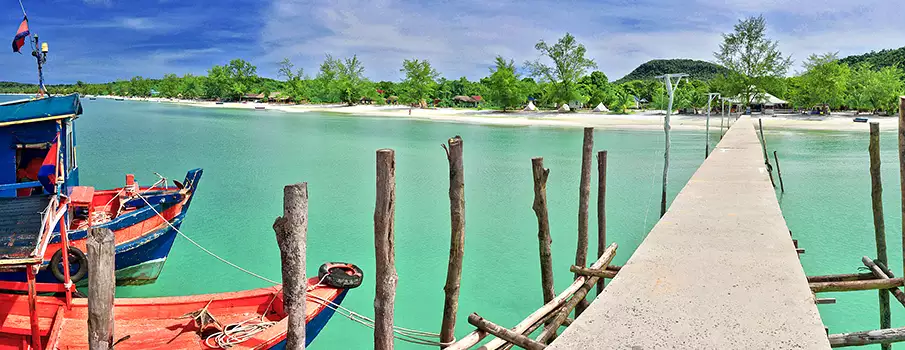
🏡 Accommodation in Cambodia / Where to Stay:
Cambodia offers a wide array of accommodation options to suit various budgets and travel preferences. From luxury resorts to budget-friendly hostels, visitors can find suitable places to stay across the country. Here are some popular types of accommodation in Cambodia:
-
- 1. Hotels and Resorts: Cambodia’s major cities and tourist destinations, such as Phnom Penh, Siem Reap, and Sihanoukville, boast a selection of hotels and resorts. From luxurious five-star properties with world-class amenities to charming boutique hotels, there are options to cater to different levels of comfort and style.
- 2. Guesthouses: Guesthouses are a common type of accommodation, particularly in smaller towns and rural areas. They offer a more intimate and personalized experience, often run by friendly local hosts. Guesthouses come in various sizes and standards, providing a budget-friendly option for travelers.
- 3. Hostels: For backpackers and budget-conscious travelers, hostels are an excellent choice. Cambodia’s cities, especially Siem Reap, offer a wide selection of hostels with dormitory-style rooms or private rooms at affordable rates. Hostels are a great way to meet fellow travelers and create a social atmosphere.
- 4. Homestays: For a more immersive cultural experience, consider staying in a homestay. Some rural areas in Cambodia offer opportunities to live with local families, allowing you to experience traditional lifestyles, customs, and cuisine firsthand.
- 5. Eco-Lodges: In Cambodia’s ecotourism destinations, such as Mondulkiri and Koh Kong, eco-lodges provide sustainable and environmentally friendly accommodation. These lodges are often nestled in nature and offer a chance to reconnect with the natural surroundings.
- 6. Boutique Guesthouses and Villas: For travelers seeking a unique and intimate experience, boutique guesthouses and villas provide a blend of comfort and charm. These establishments often have fewer rooms, ensuring personalized service and attention to detail.
- 7. Floating Villages and Houseboats: In regions like the Tonle Sap Lake, you can find floating villages and houseboats where you can spend a night on the water. This accommodation option offers a glimpse into the unique lifestyle of communities living on the lake.
- 8. Glamping Sites: For those seeking a touch of luxury in nature, glamping sites have emerged in some parts of Cambodia. These glamorous camping experiences offer comfort, amenities, and a connection with nature.
➜ Accommodation in Cambodia – Book Here
🔍 Interesting Places + Activities in Cambodia:
-
- Angkor Archaeological Park, Siem Reap: Explore the mesmerizing ancient temples of Angkor, including the iconic Angkor Wat, Bayon, and Ta Prohm. Witness intricate carvings, stunning architecture, and captivating stone faces, making it a UNESCO World Heritage Site.
- Phnom Penh’s Royal Palace and Silver Pagoda: Visit the majestic Royal Palace, the official residence of the King of Cambodia. Admire the opulent Silver Pagoda with its floor covered in silver tiles and housing a precious Emerald Buddha.
- Sihanoukville’s Beaches and Islands: Relax on the pristine beaches of Sihanoukville, such as Serendipity Beach and Sokha Beach. Take a boat trip to Koh Rong and Koh Rong Samloem islands for a secluded paradise experience.
- Kampot’s Bokor Hill Station: Explore the historic Bokor Hill Station, an abandoned French colonial resort town located atop Bokor Mountain. Discover eerie ruins, including a haunted casino, and enjoy panoramic views.
- Battambang’s Bamboo Train: Take a thrilling ride on the Bamboo Train, a unique form of local transport on a wooden platform powered by a small engine. Enjoy scenic countryside views as you glide along the tracks.
- Koh Ker Archaeological Site: Venture to Koh Ker, an ancient capital of the Khmer Empire, and discover stunning temples, including the seven-tiered Prasat Thom pyramid.
- Tonle Sap Floating Villages: Experience the floating villages of Tonle Sap Lake near Siem Reap. Witness the unique lifestyle of the local communities living on stilted houses and floating structures.
- Mondulkiri’s Elephant Sanctuary: Interact with gentle giants at an ethical elephant sanctuary in Mondulkiri. Observe elephants in their natural habitat and learn about conservation efforts.
- Kep’s Crab Market: Visit Kep’s Crab Market to savor the region’s famous crab dishes. Enjoy fresh seafood while taking in views of the ocean and nearby islands.
- Kirirom National Park: Embark on a nature escape to Kirirom National Park, offering picturesque waterfalls, pine forests, and opportunities for hiking and birdwatching.
- Kbal Spean (River of a Thousand Lingas), Siem Reap: Trek through the lush jungle to discover the sacred Kbal Spean site. Carved into the riverbed, the „River of a Thousand Lingas“ features ancient Hindu carvings that have been worshipped for centuries.
- Banteay Chhmar, Banteay Meanchey: Venture off the beaten path to Banteay Chhmar, an impressive temple complex with intricately detailed carvings and ancient ruins. Enjoy the tranquility and historical significance of this lesser-known site.
- Bokor National Park, Kampot: Experience the beauty of Bokor National Park, known for its lush forests, waterfalls, and wildlife. Explore the abandoned Bokor Hill Station and enjoy panoramic views from the mountaintop.
- Koh Sdach (King’s Island), Koh Kong: Escape to the secluded island of Koh Sdach for a serene beach retreat. Discover pristine beaches, snorkel in clear waters, and experience a peaceful island getaway.
- Cambodian Circus (Phare Circus), Siem Reap and Battambang: Be enthralled by the high-energy performances of Phare, The Cambodian Circus. This social enterprise showcases talented local artists with impressive acrobatics, storytelling, and traditional Khmer arts.
📍 Cambodia – Google Map:
❓ Frequently Asked Questions + Travel Tips for Cambodia:
1. How to book and buy tickets or flights to / in Cambodia?
2. What are the top destinations to visit in Cambodia?
-
- Cambodia is known for its ancient temples, with Angkor Wat being the most famous. Other must-visit destinations include Phnom Penh, Siem Reap, Battambang, and the coastal town of Sihanoukville.
3. When is the best time to visit Cambodia?
-
- The best time to visit Cambodia is during the dry season, which runs from November to April. The weather is pleasant, and it’s an ideal time for exploring temples and outdoor activities. The wet season, from May to October, brings lush greenery and fewer crowds.
4. How do I get around Cambodia?
-
- Cambodia has various transportation options, including buses, tuk-tuks, and domestic flights. Tuk-tuks are a common mode of transport within cities, while buses are available for intercity travel.
5. What are some must-try dishes of Cambodian cuisine?
-
- Don’t miss trying dishes like amok (coconut curry), lok lak (marinated beef), and fresh seafood from coastal regions. Cambodian cuisine is flavorful and influenced by neighboring countries.
6. Are there any health precautions to consider while traveling in Cambodia?
-
- It’s advisable to drink bottled or boiled water to avoid waterborne illnesses. Apply mosquito repellent and wear long sleeves and pants to protect against mosquito-borne diseases like dengue fever and malaria.
7. Can I visit the Angkor Wat temples independently?
-
- Yes, you can explore the Angkor Wat temples independently. However, hiring a knowledgeable guide will enhance your experience by providing historical and cultural insights.
8. Are there any cultural norms to be aware of in Cambodia?
-
- When visiting temples or sacred sites, dress modestly with covered shoulders and knees. Remove your shoes before entering someone’s home or a place of worship. Show respect to images of the Cambodian King and royal family.
9. What are some unique experiences in Cambodia?
-
- Support local businesses and artisans by purchasing handmade crafts and products. Consider visiting community-based tourism initiatives that empower local communities.
10. How can I support local communities while traveling in Cambodia?
-
- Support local businesses and artisans by purchasing handmade crafts and products. Consider visiting community-based tourism initiatives that empower local communities.
11. What are the visa requirements for Cambodia?
-
- Many nationalities can obtain a visa on arrival in Cambodia, valid for 30 days. Alternatively, you can apply for an e-visa in advance or obtain a visa at a Cambodian embassy or consulate.
12. Are there any safety concerns for tourists in Cambodia?
-
- Cambodia is generally safe for tourists, but like any travel destination, it’s essential to stay vigilant. Avoid displaying expensive items and be cautious with your belongings in crowded areas. Use reputable transportation and avoid traveling alone at night, especially in unfamiliar areas.
13. What are some lesser-known places to visit in Cambodia?
-
- While Angkor Wat and Phnom Penh are popular destinations, consider exploring off-the-beaten-path locations like Kampot, Kep, and the northeastern provinces. These areas offer a more tranquil and authentic Cambodian experience.
14. What is the weather in Cambodia and what to expect?
-
- In Cambodia, the weather is characterized by a tropical climate with distinct wet and dry seasons. The dry season, from November to April, brings lower humidity and minimal rainfall, making it an ideal time for outdoor activities. Conversely, the wet season, from May to October, sees heavier rainfall and higher humidity. It’s important to be prepared for sudden downpours during this time, and some areas may experience flooding. Checking local forecasts is advisable for more accurate and timely information on the weather in Cambodia.
15. What is the official currency of Cambodia and how to exchange money?
-
- Cambodia’s official currency is the Cambodian Riel (KHR), but the US Dollar (USD) is widely accepted and used in various transactions. The exchange rate is approximately around 4,000 KHR for 1 USD. Travelers can exchange money at banks or currency exchange booths, with banks typically providing better rates, albeit having more limited operating hours. While credit cards are accepted in some upscale establishments and restaurants, cash remains the preferred form of payment, especially in more rural regions. Therefore, it’s recommended for visitors to carry both US Dollars and Cambodian Riel, especially when venturing into less touristy areas.
BOOK a TOUR / ACTIVITY in Cambodia ➜
| Interesting Historical Facts about Cambodia: | Description |
|---|---|
| 1. Angkor – The Glorious Ancient City | Angkor, located near Siem Reap, was the capital of the Khmer Empire from the 9th to the 15th centuries. It was one of the most significant cities of its time, with a sophisticated urban layout and stunning temples, including the iconic Angkor Wat. The Khmer rulers‘ engineering prowess allowed them to create vast reservoirs and hydraulic systems, enabling agricultural prosperity. The decline of Angkor was likely due to factors such as climate change, shifts in trade routes, and political instability. |
| 2. Funan Kingdom – Early Maritime Trade Hub | The Funan Kingdom, established around the 1st century CE, was one of Southeast Asia’s earliest Indianized states. It played a crucial role as a maritime trade hub, facilitating trade between India and China. Funan’s strategic location allowed it to prosper through commerce, particularly in valuable commodities like gold, spices, and gemstones. The kingdom’s influence waned over time, paving the way for the rise of the Chenla Kingdom and later the Khmer Empire. |
| 3. Chenla Kingdom – Unification of the Lands | The Chenla Kingdom emerged in the 6th century as a successor to Funan. Under the reign of King Isanavarman I, Chenla unified various territories and tribes in present-day Cambodia and parts of Laos and Thailand. This unification marked a period of expansion and cultural assimilation, with strong Indian cultural influences seen in art, architecture, and religion. |
| 4. Rise of the Khmer Empire | The Khmer Empire, also known as the Angkor Empire, reached its peak under the reign of King Jayavarman II in the 9th century. Jayavarman II declared himself the „Universal Monarch“ and established the devaraja (god-king) concept that connected Khmer rulers to divine authority. The empire’s influence expanded across much of present-day Cambodia, Thailand, Laos, Vietnam, and Myanmar. The artistic and architectural achievements of the Khmer Empire, as seen in the grand temples of Angkor, remain awe-inspiring to this day. |
| 5. Suryavarman II and Angkor Wat | Suryavarman II, a powerful king of the Khmer Empire, commissioned the construction of Angkor Wat in the early 12th century. Angkor Wat, the largest religious monument in the world, stands as a testament to the empire’s engineering prowess and spiritual devotion. The temple was originally dedicated to the Hindu god Vishnu but later transitioned to a Buddhist place of worship. Angkor Wat remains an enduring symbol of Cambodia and an essential pilgrimage site for Buddhists. |
| 6. Fall of the Khmer Empire | The Khmer Empire began to decline in the late 13th century, facing pressure from neighboring kingdoms and internal conflicts. The sacking of Angkor by the Ayutthaya Kingdom in the 15th century marked the empire’s decline. The capital was later moved to Phnom Penh, and the kingdom faced increasing challenges from Siamese and Vietnamese forces. By the 17th century, Cambodia became a vassal state to the emerging regional powers. |
| 7. French Colonial Rule | In the 19th century, Cambodia became a French protectorate within the larger French Indochina. The French introduced administrative reforms and infrastructure development, but also imposed labor demands on the local population. King Norodom was instrumental in preserving Cambodia’s sovereignty during this period. Cambodia remained under French colonial rule until it gained independence in 1953. |
| 8. The Dark Period of Khmer Rouge | The Khmer Rouge, led by Pol Pot, took control of Cambodia in 1975 and imposed a radical communist regime. During the Khmer Rouge’s rule, Cambodia faced a period of extreme hardship, marked by forced labor, mass executions, and genocide. The notorious Killing Fields and Tuol Sleng Genocide Museum serve as painful reminders of this tragic period. The regime was overthrown in 1979, and Cambodia began its journey towards recovery and healing. |
| 9. Cambodia’s Rebirth and Modernization | After the fall of the Khmer Rouge, Cambodia went through a challenging process of rebuilding and reconciliation. The United Nations Transitional Authority in Cambodia (UNTAC) facilitated the country’s first democratic elections in 1993. Since then, Cambodia has made significant progress in economic development and infrastructure. Tourism has become a vital sector, with visitors coming to explore the rich cultural heritage and ancient wonders, including the temples of Angkor. |
| 10. Contemporary Cambodia | Today, Cambodia continues to face challenges in its political and social development. While progress has been made, issues such as poverty, corruption, and land disputes persist. Cambodia’s rich cultural heritage, including its vibrant festivals, traditional arts, and Khmer cuisine, remains an integral part of its identity. The country’s resilient spirit and determination to preserve its history and traditions make it a captivating destination for travelers seeking to explore the stories of its past and witness its journey towards the future. |
Laos – Travel Guide|Southern Vietnam – Guide|Central Vietnam – Guide|Koh Lipe – Travel Guide|Koh Phi Phi – Travel Guide|Krabi – Travel Guide


